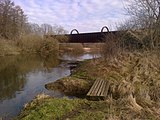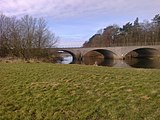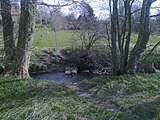Randers – Aarhus railway line
| Randers-Aarhus | |||||||||||||||||||||||||||||||||||||||||||||||||||||||||||||||||||||||||||||||||||||||||||||||||||||||||||||||||||||||||||||
|---|---|---|---|---|---|---|---|---|---|---|---|---|---|---|---|---|---|---|---|---|---|---|---|---|---|---|---|---|---|---|---|---|---|---|---|---|---|---|---|---|---|---|---|---|---|---|---|---|---|---|---|---|---|---|---|---|---|---|---|---|---|---|---|---|---|---|---|---|---|---|---|---|---|---|---|---|---|---|---|---|---|---|---|---|---|---|---|---|---|---|---|---|---|---|---|---|---|---|---|---|---|---|---|---|---|---|---|---|---|---|---|---|---|---|---|---|---|---|---|---|---|---|---|---|---|
| Route number : | Banedanmark 23 | ||||||||||||||||||||||||||||||||||||||||||||||||||||||||||||||||||||||||||||||||||||||||||||||||||||||||||||||||||||||||||||
| Course book range : | DSB 70 | ||||||||||||||||||||||||||||||||||||||||||||||||||||||||||||||||||||||||||||||||||||||||||||||||||||||||||||||||||||||||||||
| Route length: | 59.2 km | ||||||||||||||||||||||||||||||||||||||||||||||||||||||||||||||||||||||||||||||||||||||||||||||||||||||||||||||||||||||||||||
| Gauge : | 1435 mm ( standard gauge ) | ||||||||||||||||||||||||||||||||||||||||||||||||||||||||||||||||||||||||||||||||||||||||||||||||||||||||||||||||||||||||||||
| Top speed: | 160 km / h | ||||||||||||||||||||||||||||||||||||||||||||||||||||||||||||||||||||||||||||||||||||||||||||||||||||||||||||||||||||||||||||
| Dual track : | Randers-Aarhus | ||||||||||||||||||||||||||||||||||||||||||||||||||||||||||||||||||||||||||||||||||||||||||||||||||||||||||||||||||||||||||||
| Operating points and routes | |||||||||||||||||||||||||||||||||||||||||||||||||||||||||||||||||||||||||||||||||||||||||||||||||||||||||||||||||||||||||||||
|
|||||||||||||||||||||||||||||||||||||||||||||||||||||||||||||||||||||||||||||||||||||||||||||||||||||||||||||||||||||||||||||
The Randers – Aarhus railway is a railway line in Denmark that connects Aarhus with Randers in Jutland . The route is consistently two-track. The line, inaugurated on September 2, 1862, was the first line in Jutland and is part of the Østjyske længdebane ( German East Jutland longitudinal railway ), which is only called Længdebane in parlance .
history
In February 1859 the consortium Peto, Brassey and Betts received a concession to build a railway line Aarhus - Langå - Randers with the branch line from Langå to Struer . Construction began in the fall of 1859. The basis for construction was changed on December 18, 1860, when the state signed a new contract with the consortium. Then the state took over the routes for which the consortium had a concession. To this end, the consortium received further construction contracts for railway lines in Jutland and Funen . This was enshrined in the law of March 10, 1861.
Railway projects between Aarhus and Randers
In 1862 the railway followed three river valleys: the Aarhus Å valley, the Lilleå valley and the Gudenå valley . This meant a detour of about 15 kilometers compared to the direct line between the two cities, the trains to Randers from Aarhus go first to the southwest. That is why there have been repeated considerations to take a more direct route.
In 1885, engineer Holger Hammerich sketched out a plan to convert Aarhus Central Station into a through station in order to lead the Længdebane past the harbor to Aarhus Østbanegård and from there to Randers.
In 1890, Consul Steenberg, who was involved in the construction of the Vendsysselbane , suggested building a narrow-gauge railway from Randers past Clausholm and Hornslet to Mørke an der Grenaabane. The state's experts did not believe in the success of a narrow-gauge railway. In 1899, at meetings in Todbjerg and Lihme, a proposal was drawn up for the standard gauge line between Hjortshøj on the Grenaabane and Strømmen station in Randers. The proposal failed because of disagreements about execution.
In 1904, a commission began to work out plans for the Aarhus Randers Elektriske Jernbane , which was passed in the Great Railway Act of May 27, 1908, along with eight other electric railways. None of them were realized as an electric train. Aarhus – Randers Jernbane was the one whose planning progressed the furthest, as the DSB initially fought for the project. DSB feared competition from the electric train, asked many questions about the project during the concession negotiations and tried in vain to include a passage in the contract that would allow the new electric train to only transport goods between the subway stations on this route, but not between the terminus in Aarhus and Randers should allow.
In the end, DSB played the trump card with which the electric railway project was stopped: DSB would build a state railway that would use practically the same route as the electric railway directly between Aarhus and Randers and should only be 44.5 kilometers long. At the same time, Aarhus H and Randers should no longer be terminal stations for this route, where trains had to change direction.
From Aarhus H the Østjyske længdebane was to be continued on a railway embankment to Aarhus Østbanegård - as suggested by Holger Hammerich as early as 1885 - and continued along the Grenaabane past Risskov holdeplads. From here to Randers, the state railway wanted to build five stations: Vejlby , Hårup , Halling, Voldum and Ølst. In Randers, the line should lead over a new bridge over the Gudenå and lead from the southeast into the local train station.
The new state railway was to be built with two tracks, so that the urgently needed construction of a second track on the old line via Langå could be dispensed with. The Langå – Struer railway was to be connected to the Østjyske længdebane in Randers . This would extend the route to Aarhus ten kilometers. In return, a change of direction in Langå would no longer be necessary, as in Randers, as the line from Langå in Randers could be led from the west into the station.
The new Aarhus-Randers-bane was passed with the law of March 20, 1918. The route was mapped out in August 1921, but in 1922 the Folketing refused to provide the necessary funds for the project. During the further planning the fear of the competition of the car arose and the construction was not started.
Randers becomes a through station
Since the new planned route was not implemented, a second track had to be laid on the old route. This construction project was not finished until the 1930s. In this context, Randers became a through station for this route from 1936. The old route between Stevnstrup and Neder Hornbæk has been replaced by a large loop in the east. The new line crossed the Gudenå twice northeast of Stevnstrup and south of Randers. This enabled the trains from Langå to enter the south-eastern side of the station in Randers. This extended the Stevnstrup – Randers line by 800 meters from 5.9 kilometers to 6.7 kilometers.
Bridges over the Gudenå in Langå
The greatest technical challenge when building the line was the bridge over the Gudenå near Langå. It was built as a box bridge. In the German-Danish War of 1864, the Prussians blew up the bridge. This took four days and three blasts before the bridge was no longer passable. From this point in time, the rail travelers had to cross the river for 1 ½ years. The bridge was owned by the English builders, so the Germans had to pay for the new bridge, which was inaugurated on March 13, 1866.
In 1908 the Laurbjerg – Silkeborg line was opened, the first part of the diagonal line . In this context, the section between Langa and Laurbjerg was expanded to double tracks. Two new lattice bridges were built a little further west over the river, while the track over the old bridge was still used as a shunting track.
After the bridges ( Langåbrosprængningerne in Danish ) were blown up during the Second World War in 1943, it took several months to repair the lattice bridges. During this time the old bridge was used. It was ready to use after just twelve days. However, the lattice bridges had suffered permanent damage and had to be shored in the middle of the river. In addition, there were constant problems with the tight bends in the Lilleå valley west of Hadsten. From 1944 the embankment was laid over a length of 2.5 km from Laurbjerg west of Lilleå.
In 1948 this construction project was completed and the new concrete bridge completed. Together with the new dam, the route now had a much larger radius of curvature. After appropriate renovation work in Langå station, the line speed was increased in 1952 on this section and through the station from 50 to 120 km / h. In the same year the lattice bridges were demolished.
The old box bridge was classified as a monument in 1998 and now leads a bicycle and pedestrian path between Laurbjerg and Langå over the Gudenå. The repairs after the 1943 demolition can still be seen.
The blue bridge
The Randers – Ryomgård railway was originally led across Gudenå via its own bridge in a south-easterly direction from Randers station. The first bridge was built of wood in building track in 1876 and 1897 by a steel grid bridge that blå Bro was called, replaced. This bridge had four towers, two on each bank. In 1969 these towers were dilapidated and were demolished. Passenger traffic on the route ceased in 1971.
The bridge had an axle load of 16 tons. In order to increase this axle load on the line, a junction south of the Gudenå was put into operation on January 22, 1991, through which freight trains were carried until the line Randers – Ryomgård was closed in 1993. The bridge is a listed building and is only used by pedestrians and cyclists.
traffic
The route is the main route through the eastern part of Jutland. The trains from Esbjerg and Struer used them from Laurbjerg and Langa and had their terminus in Randers, where the vehicle workshop was. Especially after the closure of the Diagonalbanen , the traffic shifted from and to Struer to Aarhus. In connection with the modernization of the signaling technology from 1978 to 1979, some of the stations were closed. The line was one of the first with intercity trains, since 1979 regional trains between Århus and Struer have been running every hour.
Since January 2003, both Arriva and DSB have been using the Aarhus – Langå section for passenger transport. The Langå – Randers route is operated exclusively by DSB.
According to a tender by Transport-, Bygnings- og Boligministeriet ( German Ministry of Transport, Building and Housing ) for the implementation of regional transport in Denmark by private providers, the award of the train services between Aarhus and Langå is to be stipulated by contract for eight years from December 2020 .
Remnants of the old route
Remnants of the old railway lines can be found both on the Laurbjerg – Langå section and between Stevnstrup – Neder Hornbæk.
literature
- Asger Christiansen: Aarhus-Randers electric Jernbane . Bane Bøger, Smørum 1984, ISBN 87-88632-04-0 (Danish).
Individual evidence
- ^ Association of Central European Railway Administrations (ed.): Station directory of the European railways . (formerly Dr. Koch's station directory). Barthol & Co., Berlin-Wilmersdorf 1939.
- ↑ Signal post . No. 3 , 1972, p. 97 .
- ↑ The painter Otto Bache painted passengers on the ferry across the Gudenå.
- ^ Randers official notification on July 30, 1948.
- ↑ Langå Lokalarkiv, pictures of the former lattice bridge. Retrieved December 5, 2014 (Danish).
- ↑ Den blå bro. In: HistoriskAtlas.dk. Retrieved December 5, 2014 (Danish).
- ↑ Flere togstrækninger kommer i udbud. Transport-, Bygnings- og Boligministeriet, June 9, 2017, accessed November 4, 2018 .
Web links
- Danmarks jernbaner. In: The Danske store . Retrieved December 3, 2014 (Danish).
- Lidt historie om Århus og jernbanen. Skanderborg Modeljernbane Klub, accessed December 3, 2014 (Danish).




